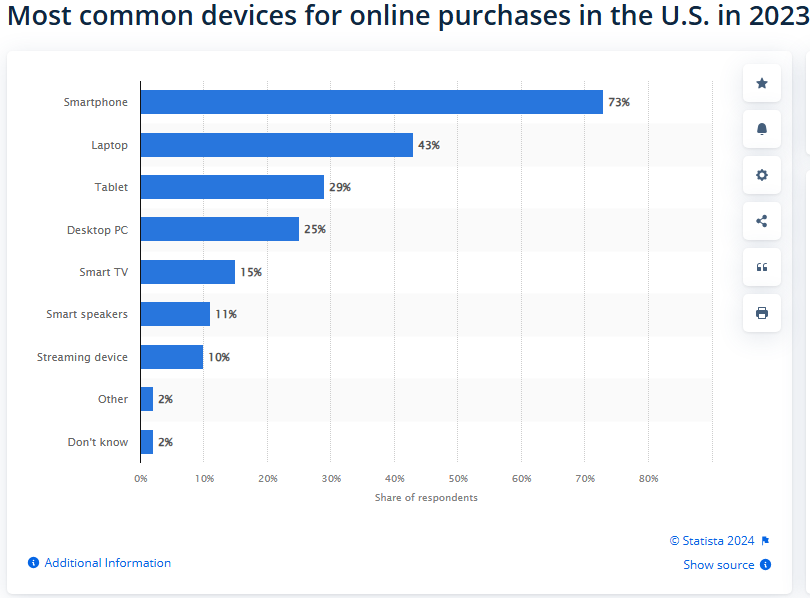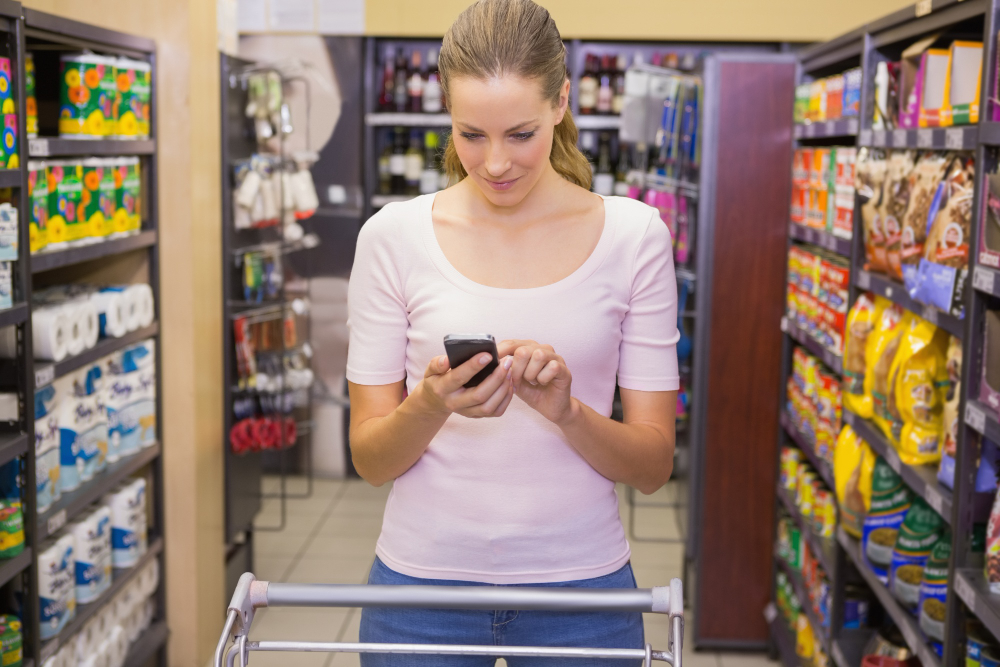“Consumers are leading the mobile shift, using mobile at any number of points along the purchase journey. Whether they are researching, browsing, or actively purchasing, consumers don’t recognize “mobile” as a separate channel, but rather as simply another way to interact with the brands of their choosing.” – Porch Group Media.
Consumers today increasingly rely on mobile devices when they decide to go shopping. It is no surprise that smartphones are the devices of choice due to their portability and convenience; allowing shoppers to browse and purchase items from any location. Tablets and laptops are a close second, offering larger screens and easy navigation for more detailed product research.
Retail business owners must understand these consumer preferences and trends to tailor their digital strategies. This article explores consumers’ use of mobile devices for in-store shopping and examines how retailers can adapt their digital strategies to accommodate customer preferences and retail industry trends.
Why have mobile devices become important to shoppers?
Mobile devices have become a staple tool for modern shoppers due to the convenience and flexibility they provide. Smartphones, in particular, allow customers to compare prices, read product reviews, and find product information in real-time, whether shopping online or in-store. Moreover, many consumers use their phones to check store hours, locate physical stores, and access directions, while others monitor product availability or browse online sales from the comfort of their homes.
The trend toward device-assisted shopping continues to rise as consumers prioritize accessibility, speed, and seamless customer experiences. Customers that shop in physical stores, use smartphones to quickly verify if they are getting the best price, search for alternative products, or read customer reviews to make informed purchase decisions. This trend in retail, reflects a growing reliance on digital tools to bridge the gap between physical and online shopping experiences.
What devices do consumers rely on for in-store shopping?
Research conducted by 1WorldSync reports a growing trend in the use of mobile devices for in-store shopping. The study found that the number of shoppers who consistently use smartphones for product research while in-store doubled from 2023, with 11% of shoppers using their phones on every shopping trip.

In addition, the average shopper now uses their smartphone during more than half of their shopping experiences (54%), an increase of five percentage points from 2022 and 2023. This shift indicates that mobile technology’s role in retail has grown beyond convenience to become a normal part of the shopping journey.
How do shoppers use devices when shopping?
Here are some examples of how shoppers use mobile devices when engaging in shopping activities:
Product Research
The most common use of smartphones in retail is for researching products. Consumers use their phones to read product reviews, watch videos, and check product specifications, even while in-store. This practice, often called “webrooming,” helps shoppers confirm their purchase decisions and avoid buyer’s remorse. By researching items while standing in a physical store, customers gain confidence in their choices and are less likely to return products later.
Price Comparison
Another popular activity is comparing prices across different retailers. Shoppers use apps and mobile websites to find better deals or promotions, often leveraging price-matching policies offered by stores. This practice empowers consumers to make cost-effective purchasing decisions on the spot.
Mobile Payments and Digital Wallets
As more stores adopt mobile payment systems like Apple Pay, Google Wallet, and Samsung Pay, consumers are increasingly using their smartphones to complete transactions. Digital wallets simplify the checkout process and offer added security features, such as biometric authentication. Moreover, loyalty programs and digital coupons can be integrated with mobile payment apps, giving consumers more incentives to use their smartphones during transactions.
Shopping List and Alerts
Many shoppers use their mobile devices to create shopping lists, set reminders, or receive alerts about ongoing promotions. Retailer apps that offer personalized notifications based on browsing history or past purchases help increase engagement and drive sales.

How Can Retail Stores Support Consumer Usage of Devices?
Retail businesses can enhance the shopping experience by adapting to the growing consumer reliance on mobile devices. Here are several strategies to consider:
I) Provide Free In-Store Wi-Fi
Offering free Wi-Fi encourages shoppers to use their mobile devices in-store for product research, price checks, and mobile payments. This convenience can make shopping more enjoyable and increase the time customers spend in the store.
II) Enable Mobile-Friendly Websites and Apps
With so many consumers relying on their smartphones, it’s essential for retailers to have mobile-optimized websites and apps. This ensures that customers have a seamless experience when accessing product information, checking availability, or making purchases. A responsive design that works well across different screen sizes can help retain customers who prefer mobile browsing.
III) Integrate Mobile Payment Options
As mobile payments become more popular, integrating options like Apple Pay, Google Pay, and PayPal at checkout is essential. This convenience can attract tech-savvy shoppers who prefer contactless payment methods. Additionally, providing digital receipts can reduce paper waste and support sustainability efforts.
IV) Incorporate QR Codes for Product Information
QR codes can provide customers with instant access to product details, reviews, or how-to guides. By scanning a code with their smartphone, shoppers can get the information they need without waiting for assistance. This can also help reduce the load on store associates during busy hours.
V) Leverage Mobile Loyalty Programs
Retailers can encourage mobile usage by offering loyalty programs accessible through a smartphone app. Features like digital coupons, rewards tracking, and personalized offers based on shopping habits can motivate customers to engage more frequently. Retail apps with integrated loyalty programs also help drive foot traffic and increase sales.
VI) Use Location-Based Marketing
Retailers can benefit from using geolocation services to send push notifications about sales, special events, or new arrivals when customers are near or inside the store. Personalized, location-based alerts can increase foot traffic and improve customer engagement.
VII) Support Voice Search and AI Chatbots
As voice search becomes more popular, retailers should ensure their mobile websites and apps can accommodate voice-activated queries. AI-powered chatbots can also assist customers by answering common questions or guiding them through the shopping process, enhancing the user experience.
“Over 50% of Mobile Assisted-Shoppers are more likely to purchase a product in-store when their mobile device helps them get online reviews, information, or trusted advice” – Mathew Quint and David Rogers, Columbia Business School.
Final Comments
The increasing use of mobile devices for retail shopping reflects a shift in consumer behavior toward convenience and information-driven decision-making. As more consumers integrate smartphones into their shopping routines, retailers must adapt by embracing mobile-friendly strategies and offering tools that optimize the device-assisted shopping experience, online and in-store. With the right plan in place, businesses can support shoppers’ evolving needs while increasing sales and improving customer loyalty.
Thank you for reading our article!
TimeWellScheduled is a secure online time and attendance software 100% tailored to meet your scheduling needs! In Addition, our cloud-based scheduling solution optimizes employee attendance tracking, simplifies payroll administration, and enhances staff management capabilities. Plus, our service is free for up to 10 employees!
Click here to download our (Excel) employee scheduling template; It’s free!





